President George W. Bush pledged repeatedly throughout his presidential campaign that his administration would have no use for polls and focus groups: “I really don’t care what polls and focus groups say. What I care about is doing what I think is right.” Shackled by that promise, President Bush and his staff have shrouded his polling apparatus, minimizing the relevance of polls and denying their impact. But public records available from the Federal Election Commission, documents from presidential libraries, and interviews with key players paint a fairly clear picture of the Bush polling operation. The picture, which turns out to be a familiar one, calls into question the administration’s purported “anti-polling” ethos and shows an administration closely in keeping with historical precedent.
President Bush in Historical Context
Every president since Richard Nixon has hired professional pollsters to take, periodically, the pulse of the electorate. Earlier presidents clearly had relationships with pollsters, who obligingly tacked questions onto their existing polls for the benefit of the administration. But polling was not under White House control. Nixon’s use of pollsters marked a turning point in the history of presidential polling because it signaled the birth of White House-commissioned polls. No longer tethered to the timetables and agendas of pollsters like Lou Harris and George Gallup, presidents began to direct both the timing and the substance of their polls. Nor were polls limited to the campaign season; presidents and their staff could test the popularity of various programs and policy initiatives on their own schedule. Scholars, noting that the transfer of campaign tactics to governing was blurring the distinction between the two, began describing the result as the “permanent campaign.”
Rapid advances in technology played a big part in the new ways presidents used polling. By the time Nixon took office, computers, though costly, had become sophisticated enough to process vast quantities of data. Not only were telephones ubiquitous enough to make their use in polling methodologically feasible, but the advent of random digit dialing increased the efficiency and validity of telephone polling. In short, the “science” of polling became more mature, enabling presidents not only to learn about their past performance but to gain “prospective” intelligence. Today, testing key phrases in a speech or catchphrases designed to sell a policy or program has become so commonplace that presidential speeches and public pronouncements endure many rounds of focus group testing before being judged ready for primetime. Innovative techniques like the mall intercept (interviewing shoppers at a mall storefront), tracking polls, overnight polling, dial meters, and focus groups are part of any professional pollster’s repertoire. And new Internet focus groups are being used, by the Bush pollsters among others, as a more timely, less expensive way to conduct focus groups. Though still in its nascent stages, Internet polling is thought to be the next generation of survey research, significantly lowering costs while increasing the speed with which polls can be conducted.
The names of many past presidential pollsters are familiar, if not exactly household names. Robert Teeter did polling for Presidents Nixon, Ford, and George H.W. Bush; Patrick Caddell for President Carter; Richard Wirthlin for President Reagan; and Stanley Greenberg (1993-94) and Mark Penn (1995-2000) for President Clinton. Most began as pollsters for the campaign and were “promoted” to presidential pollsters, taking on a higher profile in the process. Indeed, the unprecedented visibility and perceived influence of Clinton’s pollsters created much advance interest in President George W. Bush’s prospective pollsters. But Bush’s determination to be the “anti-Clinton” and his repeated campaign promises to give polls and focus groups no role in his administration led him to relegate his pollsters to near anonymity. Still, their low profile, particularly compared with that of Clinton’s pollsters, has not kept them from performing essential polling for the White House.
By the Numbers
The Republican and Democratic National Committees subsidize presidential political expenses such as polling and political travel and routinely report those expenses to the Federal Election Commission. Table 1 sets out polling expenditures only for designated presidential pollsters during the first two years of the Reagan, Bush I, Clinton, and Bush II administrations. The pollsters for the second Bush administration come in well behind those of Presidents Reagan and Clinton and only slightly ahead of the first Bush administration. Though the parties spent extraordinary amounts on both Reagan and Clinton, Reagan’s administration was popularly perceived as being driven by deeply rooted philosophical principles while Clinton’s was seen as merely pandering—suggesting that polling does not always taint a president’s reputation.
When the party of the president is in power, the national committee becomes a veritable White House annex staffed with loyalists eager to secure the president’s reelection. Toward that end, no amount of polling is too much, particularly when the polling can also inform broader party strategy and statewide campaigns. A look at Republican National Committee spending on polling more generally (not just designated presidential pollsters) reveals that it spent roughly $3.1 million during the first two years of the current Bush administration. And even that figure understates the polling available to the White House because it does not include polling conducted on behalf of the National Republican Senatorial Committee and the National Republican Congressional Committee, which totals some $6.5 million—more than double what the RNC spent on polling. Though neither of those organizations is responsible for subsidizing White House polling, Bush’s presidential pollsters, Jan van Lohuizen (Voter/Consumer Research) and Fred Steeper (Market Strategies), have done work for these committees totaling more than $800,000—a sum that if added to presidential polling would bump up the Bush total to $2.5 million, more than $1 million more than Bush I. And Karl Rove’s extraordinary sway makes it unlikely that any request by him for statewide polls that might be of interest to the president would be denied either by the president’s pollsters or by any pollsters doing work for the RNC. In addition, the RNC spent $2.7 million on “political consulting.” And although the FEC reports do not detail the various projects, the reports include work by former White House adviser Karen Hughes and a broad range of Republican consulting firms.
As interesting as the total amount of RNC spending on polling is its timing (figure 1). Rather than being more or less consistent monthly, spending peaks in ways that seem hard to explain. Though noteworthy events—the September 11 attacks and the midterm elections—may account for two of the peaks, Matthew Dowd, senior adviser at the RNC, has indicated that events do not necessarily drive polling. And while pollsters may be interested in gauging the impact of unexpected events or new developments, their billing is not systematic in a way that could support the event-driven explanation. Nevertheless, a statistical regression analysis reveals a general trend upward, roughly an average increase of $4,000 a month, suggesting that, over time, there are forces driving the RNC to spend more money on polling. Short of obtaining White House-commissioned polls, it is impossible to define the precise role that events play in polling. Regardless, the variation in spending reflects the idiosyncratic usage of polling within the Bush administration.
| Table 1. National Party Presidential Polling Expenditures (in 2002 Dollars) |
|||
|---|---|---|---|
| Administration | First year | Second year | Total |
| Reagan— Richard Wirthlin |
$1,635,000 | $2,531,000 | 4.1 million |
| Bush I— Robert Teeter |
831,683 | 470,811 | 1.3 million |
| Clinton— Stanley Greenberg |
2,433,000 | 2,415,000 | 4.8 million |
| Bush II— Jan van Lohuizen and Fred Steeper |
715,771 | 947,422 | 1.7 million |
| *Data for the current administration obtained on-line from fec.gov with the assistance of Elizabeth Redman and Larissa Davis of the Brookings Institution, April 2003. All other data obtained by author. | |||
Why Poll?
Presidential documents and interviews with White House staff and pollsters from past administrations suggest that presidents use polling for two primary reasons. The first is tactical. Given the limited resources available to them, new presidents must determine the best way to sell their agenda, minimizing costs and maximizing their influence. Campaign professionals, armed with state-of-the-art public opinion technology and an “outside the Beltway” perspective on pressing issues and problems, provide a service that the modern White House is unequipped to offer. The second reason, rooted in democratic theory, is a president’s desire to represent his constituents by acting in consonance with a majority of the public. Although the Bush administration is willing to admit it uses polls to help package and sell its policies to the public, it regards as heresy any suggestion that it follows the polls (even the Clinton administration denied that it used polls for this purpose).
Regardless, presidential pollsters from all administrations since Nixon’s have been known to poll on foreign and domestic issues alike. Nixon polled about Vietnam and about admitting China to the United Nations. Carter surveyed American attitudes toward Israel and the Iran hostage crisis. Reagan tracked polls on the Iran-Contra affair and the Marine barracks bombing in Lebanon. During President George H.W. Bush’s administration, pollsters Robert Teeter and Fred Steeper conducted polls and focus groups both before and during the Gulf War. Examples of polling on domestic policy—busing, agriculture, government regulation, bilingual education, health care policy, energy, and the budget—abound. Presidential pollsters provide additional data before midterm elections and become pivotal during the president’s reelection campaign. Typically, the fourth year of the president’s term generates the highest spending on polling. Speech content is another area where pollsters can provide useful advice. Finally, all presidential pollsters need to collect national tracking polls on a regular basis to provide an internal baseline to compare against other polls. In short, presidential polling is a staple of the modern presidency.
Consumer of Polls: The Bush Political Machine
The way one political insider explained President Bush’s attitude toward polling reinforced the president’s campaign mantra: “One of the worst arguments a White House adviser can make to the president is to say that “the polls show X.’” But despite the president’s disdain for public opinion polls, he has created a formidable White House political operation that focuses closely on them. The Office of Strategic Initiatives monitors and analyzes the results of numerous public surveys by major networks and news organizations as well as the findings of privately commissioned polls. And access to state surveys and other polls conducted by GOP pollsters informs their analyses. Why does the nature of the White House political operation matter? Because no amount of polling is worthwhile unless it is properly analyzed and incorporated into White House policy and political discussions.
President Bush’s chief political confidant, Karl Rove, is considered by Republicans and Democrats alike to be an extraordinarily shrewd presidential adviser. On entering the White House in 2001, Bush established the first White House Office of Strategic Initiatives and appointed Rove its director—giving him a perch from which to survey the political landscape with the aim of expanding the president’s electoral coalition in 2004. Unlike Bush’s father, who placed his chief political adviser, Lee Atwater, at the helm of the RNC, George W. Bush understands the importance of proximity. Though the president deliberately distances himself from pollster Jan van Lohuizen (political insiders claim the two rarely meet), his close relationship with Rove virtually ensures a key role for polling in presidential policymaking.
Assisting Rove as chief political adviser is Matthew Dowd, the RNC senior adviser who coordinates the pollsters and analyzes the political pulse with the help of van Lohuizen, who conducts focus groups as well as national surveys. And Fred Steeper, 1992 campaign pollster for Bush’s father, is assigned a variety of special projects that address specific research questions, some of which involve focus groups. Combining the less “scientific” focus groups with polling enables the political shop to determine what people are thinking and then test those attitudes rigorously through national surveys. Unlike survey research, the focus group allows researchers to present text from a speech or a segment of a television ad and gauge the intensity of emotions, observe body language, and probe more deeply on key issues. The focus group alone may not be especially helpful, but combined with survey research, it can create a more refined questionnaire that zeroes in on previously tested issues and preferences. Similarly, the focus group technique can be applied after a national survey to probe specific questions and issues. The Steeper-van Lohuizen team clearly enhances the value of survey research while the Rove-Dowd-van Lohuizen/Steeper chain of command ensures that the pollsters stay well outside the political circle—and away from the eyes of the White House press corps.
The final part of this well-oiled political machine is the White House Office of Political Affairs director and recipient of polling data, Ken Mehlman. Since the Reagan administration, this office has become a standard component of all White House political operations, but its influence depends largely on the president and his chief aides. The first President Bush downplayed the office, and it experienced high turnover during the first term of the Clinton administration. But in today’s White House, Ken Mehlman’s job is deemed an important one—though unlike Karl Rove’s macropolitical strategy, Mehlman tends to the care and feeding of state and local partisans in hopes of paving the way for victory in 2004.
White House Polling in Perspective: Perception Is Everything
President Bush’s use of polling is by no means pathbreaking, nor is the amount of polling particularly astounding. What is unusual about the Bush team’s polling operation is the chasm between its words and actions. Never before has a White House engaged in such anti-polling rhetoric or built up such a buffer between the pollsters and the president. The placement of longtime Bush loyalist Dowd at the RNC to coordinate the polling means that the pollsters do not have contact with the White House. Such unusual behavior reflects a broader tension between a determined attempt to avoid the mistakes of Bush the elder—especially the failure after the Persian Gulf War to consider the implications of a stagnant economy for the 1992 reelection campaign—and a continuous effort to shed the vestiges of the Clinton administration. The Bush team fully understands the value of polling, but the perceived overuse of polling within the Clinton administration has led to serious overcompensation, which in turn has bred secrecy and denial. All presidents are subjected to the pressures of the “permanent campaign” Information is integral to any successful presidency. Polling is part of a broader game of politics and policymaking. No one can dictate how presidents use polls, but denying the role of polls in the policy process is fruitless.

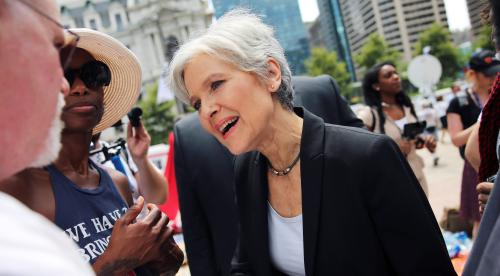
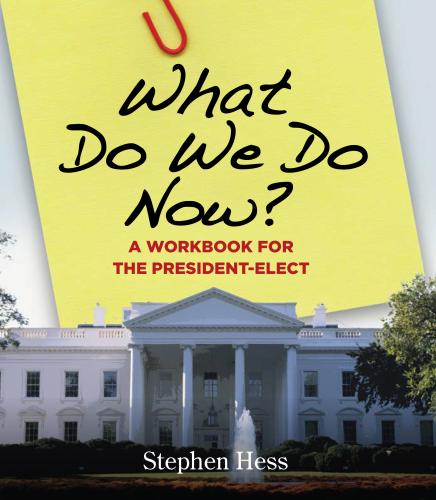
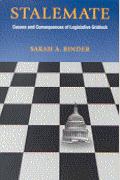
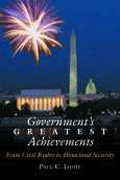
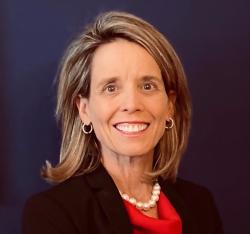



Commentary
Words vs. Deeds: President George W. Bush and polling
June 1, 2003